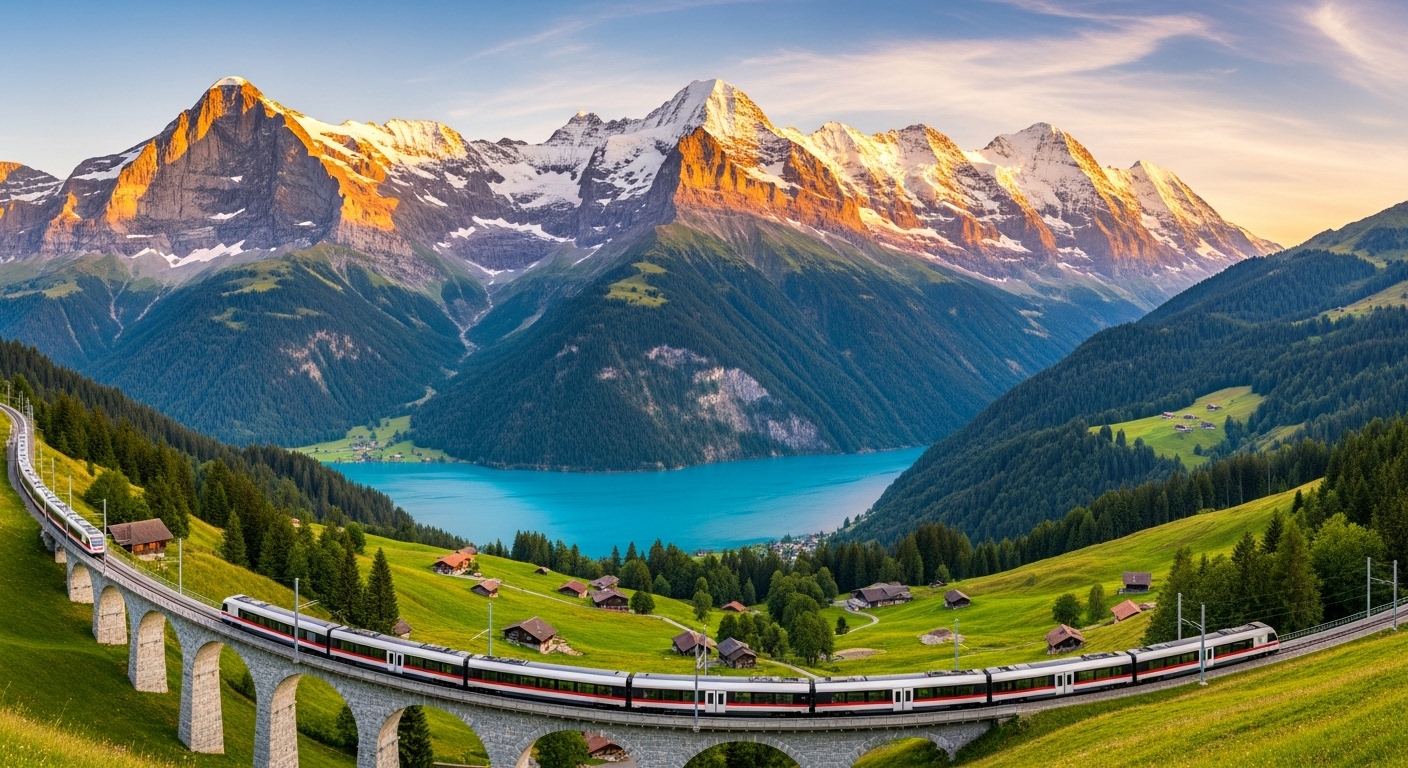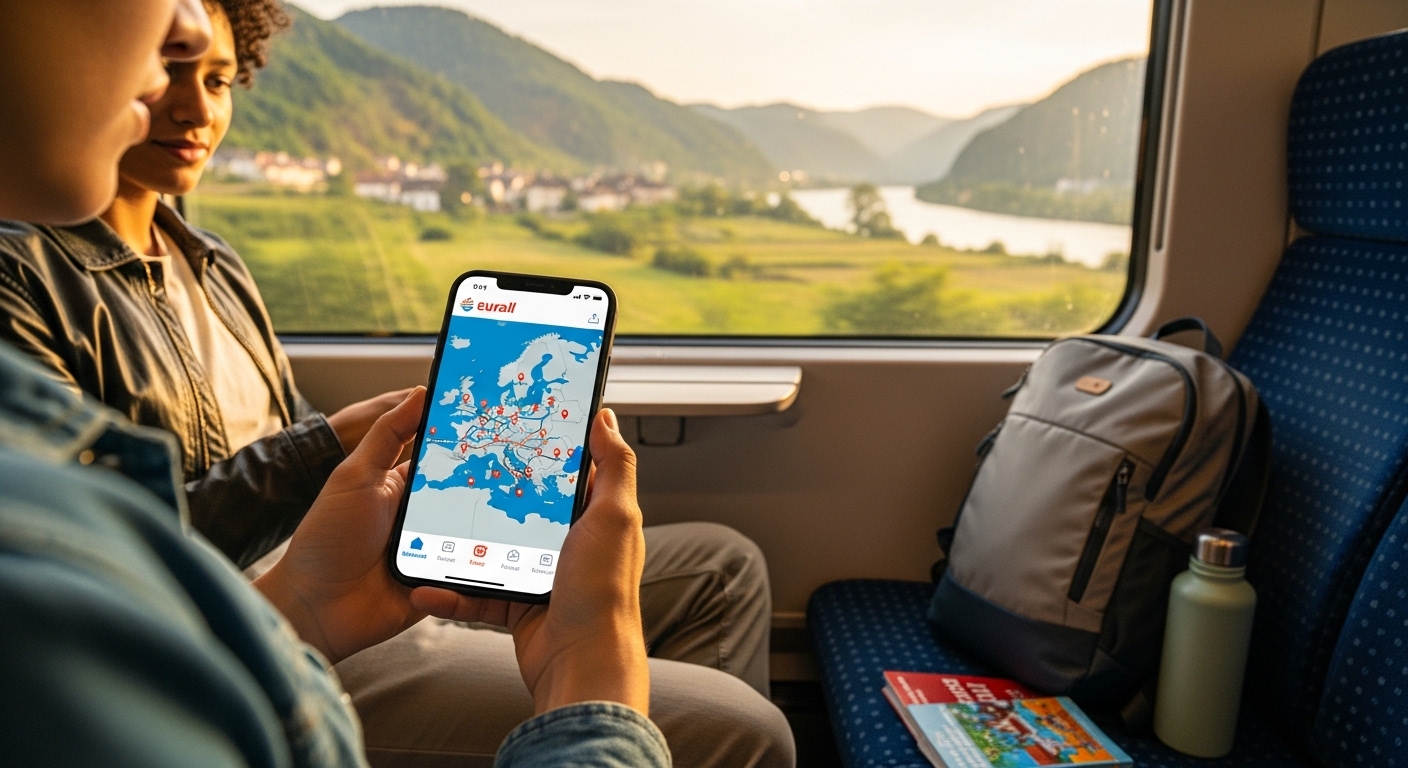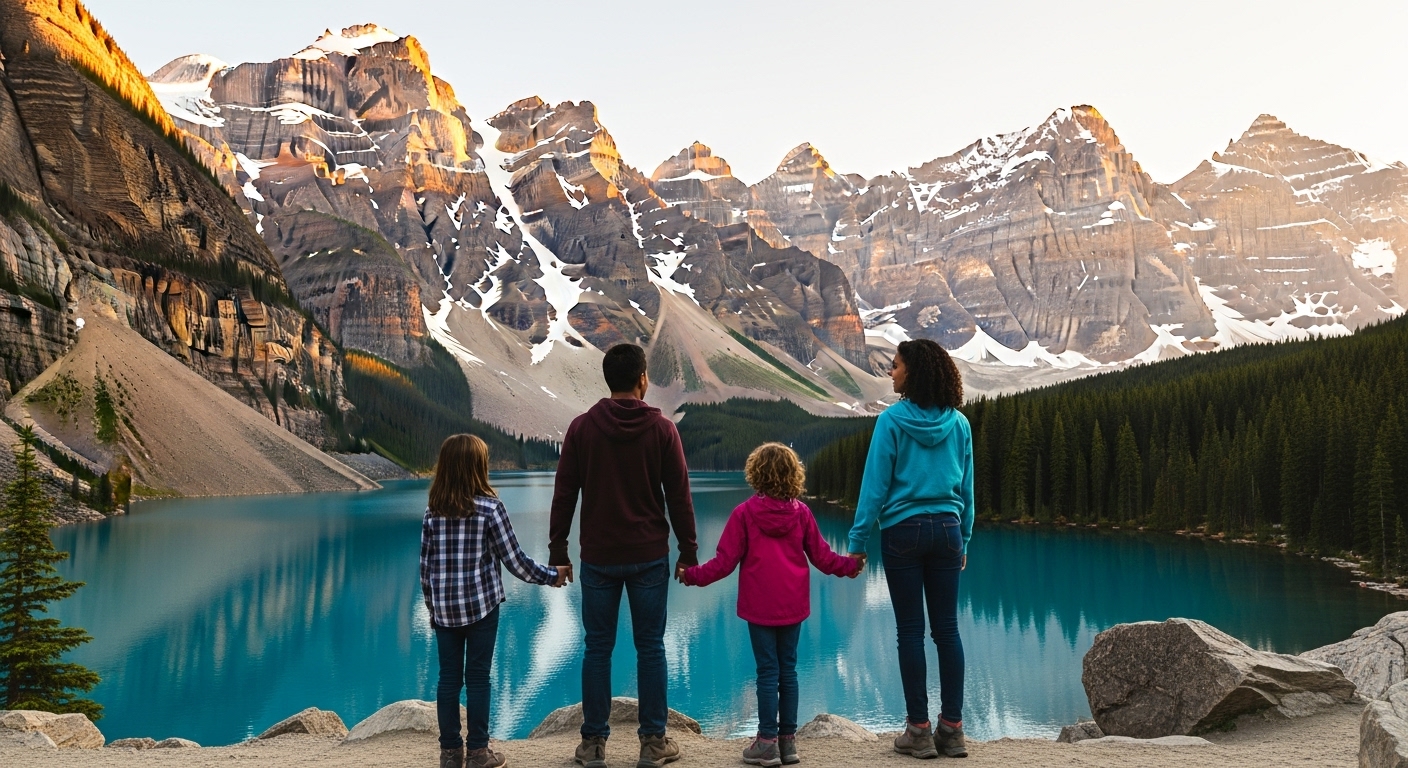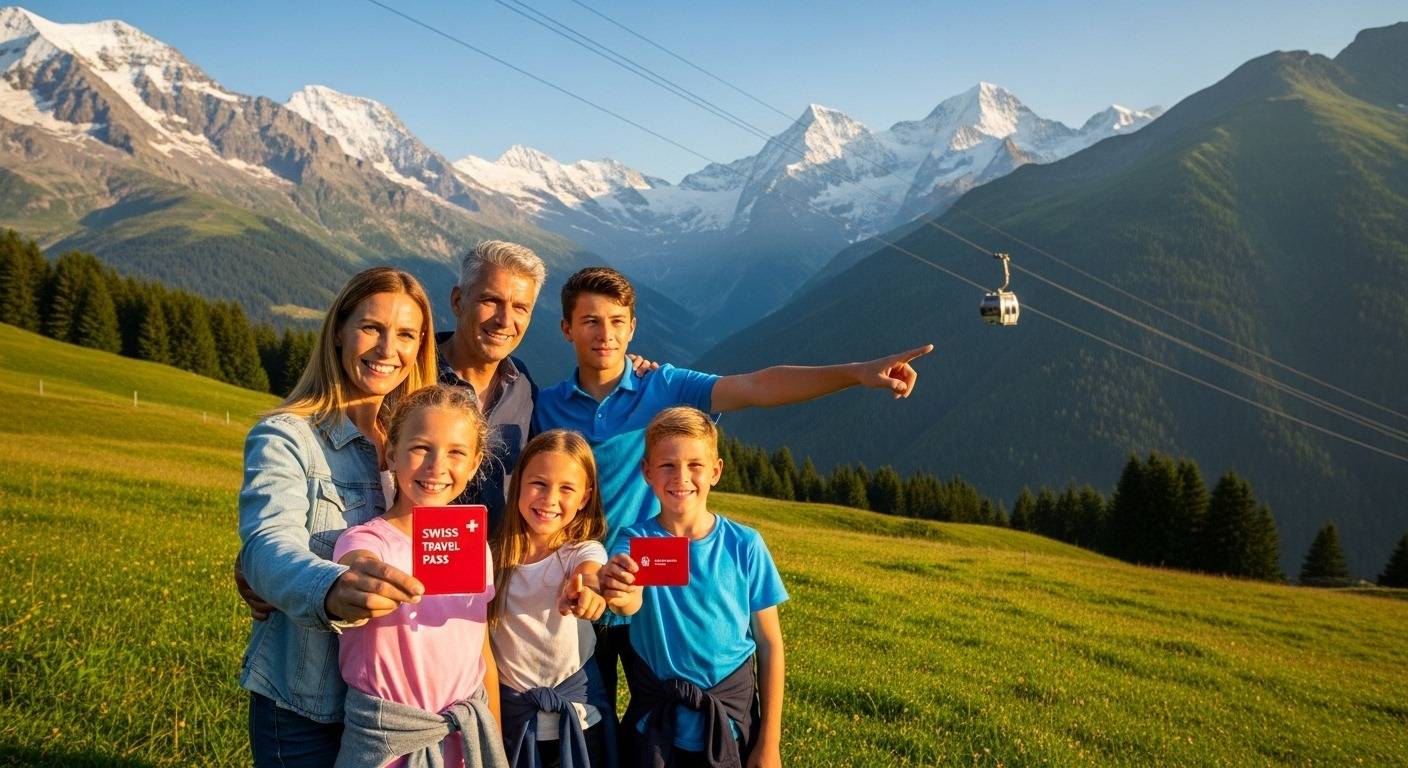# Swiss Travel Pass vs Regional Passes: Bernese Oberland Guide
Deciding between the Swiss Travel Pass vs Regional Passes can feel as daunting as choosing which stunning Alpine peak to conquer first. You’ve seen the pictures, planned the hikes, and now you’re stuck in a spreadsheet nightmare, trying to figure out if the all-in-one convenience of the Swiss Travel Pass outweighs the focused power of a pass like the Berner Oberland Pass. It’s the single most important decision for your budget, and getting it wrong can cost you hundreds.
This guide is here to end the confusion. We’re going to break down the Swiss Travel Pass vs Regional Passes debate with a practical, cost-focused analysis. We’ll use popular itineraries to give you a clear, data-driven answer on which pass offers the best value for your adventure. For full details, you can always check the Official Swiss Travel Pass information and booking page.
Table of Contents
- Swiss Travel Pass vs Regional Passes: The Main Contenders
- Key Pass Variations: Consecutive vs. Flex
- The Break-Even Point in the Swiss Travel Pass vs Regional Passes Debate
- Swiss Travel Pass vs Regional Passes: A 7-Day Itinerary Comparison
- Cost Analysis: 7-Day Geneva & Bernese Oberland Itinerary
- Expanding the Swiss Pass Comparison: A 10-Day Itinerary
- Swiss Travel Pass vs Berner Oberland Pass: Which is Better?
- The Lake Geneva Regional Pass Factor
- Our Verdict: Choosing Between the Swiss Travel Pass vs Regional Passes
- Conclusion: Making the Right Pass Choice for Your Trip
Swiss Travel Pass vs Regional Passes: The Main Contenders
Before we dive into a head-to-head comparison, let’s define our three champions. Think of it as choosing between a master key, a specialized key, or a universal discount card.
- The Swiss Travel Pass (STP): This is your all-access master key. It’s a single pass that covers nearly all public transport—trains, buses, and boats—across the entire country for a consecutive number of days. It also includes free entry to over 500 museums and offers significant discounts (typically 25-50%) on most mountain excursions. The pass also fully covers panoramic train routes, though seat reservations are extra; for details, check the Glacier Express official website.
- Regional Passes: These are the specialized keys, designed to unlock one specific region in incredible depth. The Berner Oberland Pass is the superstar here, offering extensive coverage—often 100% free travel—on many local trains, buses, boats, and even numerous mountain cable cars within that iconic region. Similarly, the Lake Geneva Regional Pass provides focused benefits around that area.
- The Swiss Half-Fare Card: This is your universal discount card. For a flat fee (currently 120 CHF for one month), this card entitles you to a 50% discount on virtually all train, bus, boat, and even most mountain excursion tickets across the entire country. You still have to buy a ticket for every journey, but always at half the price. It requires more effort but can offer huge savings.
Key Pass Variations: Consecutive vs. Flex
A common point of confusion is choosing between the standard Swiss Travel Pass (consecutive) and the Swiss Travel Pass Flex. Here’s a quick breakdown of the pros and cons.
- Swiss Travel Pass (Consecutive):
- Pros: Ultimate convenience. Once activated, it’s valid for a set number of days in a row (3, 4, 6, 8, or 15). You never have to think about buying a ticket. It’s perfect for trips with daily travel.
- Cons: If you have “rest days” where you stay in one village, you’re paying for a travel day you aren’t fully using.
- Swiss Travel Pass Flex:
- Pros: Offers a set number of travel days to be used within a one-month period (e.g., 4 days in 1 month). This provides great flexibility if your itinerary includes non-travel days for long hikes or relaxation.
- Cons: It’s more expensive per travel day than the consecutive pass. You must remember to activate a travel day online before your first journey each day, which adds a small administrative step.

A Swiss train in the Bernese Oberland, central to the Swiss Travel Pass vs Regional Passes decision
The Break-Even Point in the Swiss Travel Pass vs Regional Passes Debate
To quickly gauge if a Swiss Travel Pass is right for you, you can calculate a rough break-even point. A full-fare, long-distance train journey in Switzerland (e.g., Zurich to Interlaken or Geneva to Zermatt) typically costs between 75-125 CHF.
- How to Calculate: Take the cost of the Swiss Travel Pass and divide it by the average cost of a long-distance trip.
- Example: An 8-day Swiss Travel Pass costs ~429 CHF. If we use an average trip cost of 85 CHF, the calculation is 429 / 85 = ~5.0.
- Conclusion: This means you would need to take approximately five to six long-distance trips for the Swiss Travel Pass to break even on travel alone. This doesn’t even count the added value of free museum entries, boat cruises, and city transport, which lower the break-even point further.
Swiss Travel Pass vs Regional Passes: A 7-Day Itinerary Comparison
To make this Swiss pass comparison tangible, let’s map out a classic 7-day itinerary that hits two of the country’s most beloved regions.
- Day 1: Arrive in Geneva, explore the city, and travel to Montreux.
- Day 2: Explore Montreux, including Chillon Castle and a boat trip on Lake Geneva.
- Day 3: Travel the scenic GoldenPass route from Montreux to Interlaken.
- Day 4: Explore the Lauterbrunnen Valley and take the cable car up to Schilthorn.
- Day 5: Day trip to Grindelwald-First for the Cliff Walk and adventure activities.
- Day 6: Excursion towards Jungfraujoch – Top of Europe.
- Day 7: Travel from Interlaken to Zurich Airport (ZRH) for departure.
Cost Analysis: 7-Day Geneva & Bernese Oberland Itinerary
Now for the main event. Let’s analyze the costs for our 7-day itinerary. We’ll compare an 8-day Swiss Travel Pass, a Half-Fare Card, and a Regional Pass combo. All prices are estimates for a single adult in 2nd class and can be verified using the Official Swiss Travel Pass information and booking.
Base Pass Cost
- Swiss Travel Pass (8-Day): ~429 CHF
- Regional Pass Combo (6-Day BO Pass + Tickets): ~290 CHF (BO Pass) + Point-to-Point Tickets
- Swiss Half-Fare Card: 120 CHF + 50% of all tickets
Day 1: Geneva to Montreux
- Swiss Travel Pass (8-Day): Fully Covered
- Regional Pass Combo (6-Day BO Pass + Tickets): ~30 CHF
- Swiss Half-Fare Card: ~15 CHF
Day 3: Montreux to Interlaken
- Swiss Travel Pass (8-Day): Fully Covered
- Regional Pass Combo (6-Day BO Pass + Tickets): Fully Covered
- Swiss Half-Fare Card: ~33 CHF
Day 4: Schilthorn Excursion
- Swiss Travel Pass (8-Day): 50% Discount (~43 CHF)
- Regional Pass Combo (6-Day BO Pass + Tickets): Fully Covered (100% Free)
- Swiss Half-Fare Card: 50% Discount (~43 CHF)
Day 5: Grindelwald-First Excursion
- Swiss Travel Pass (8-Day): 50% Discount (~32 CHF)
- Regional Pass Combo (6-Day BO Pass + Tickets): Fully Covered (100% Free)
- Swiss Half-Fare Card: 50% Discount (~32 CHF)
Day 6: Jungfraujoch Excursion
- Swiss Travel Pass (8-Day): 25% Discount (~160 CHF)
- Regional Pass Combo (6-Day BO Pass + Tickets): Fixed Price (~99 CHF)
- Swiss Half-Fare Card: 50% Discount (~107 CHF)
Day 7: Interlaken to Zurich Airport
- Swiss Travel Pass (8-Day): Fully Covered
- Regional Pass Combo (6-Day BO Pass + Tickets): ~75 CHF
- Swiss Half-Fare Card: ~38 CHF
Other Costs (Castle, local transport)
- Swiss Travel Pass (8-Day): Mostly Covered
- Regional Pass Combo (6-Day BO Pass + Tickets): ~15 CHF
- Swiss Half-Fare Card: ~10 CHF
Convenience
- Swiss Travel Pass (8-Day): Highest. One pass for everything.
- Regional Pass Combo (6-Day BO Pass + Tickets): Medium. Requires buying a few extra tickets.
- Swiss Half-Fare Card: Lowest. Requires buying a ticket for every single journey.
ESTIMATED TOTAL COST
- Swiss Travel Pass (8-Day): ~664 CHF
- Regional Pass Combo (6-Day BO Pass + Tickets): ~509 CHF
- Swiss Half-Fare Card: ~498 CHF
Analysis: For this specific, mountain-heavy itinerary, both the Regional Pass combo and the Half-Fare Card come out significantly cheaper than the Swiss Travel Pass. The Half-Fare Card is the ultimate winner on price, but it comes at the cost of convenience, as you must purchase a ticket for every trip.
Expanding the Swiss Pass Comparison: A 10-Day Itinerary
Let’s test the passes on a longer, more complex itinerary focused on two major mountain destinations.
- Days 1-2: Arrive in Zurich, travel to Zermatt. Explore Zermatt.
- Day 3: Gornergrat excursion for Matterhorn views.
- Day 4: Travel from Zermatt to Lauterbrunnen.
- Days 5-8: Explore the Bernese Oberland (e.g., Schilthorn, Männlichen, hiking).
- Day 9: Excursion to Jungfraujoch – Top of Europe.
- Day 10: Travel from Lauterbrunnen to Zurich Airport for departure.
Cost Analysis (10-Day Itinerary):
Swiss Travel Pass (15-Day)
- Base Pass Cost: ~512 CHF
- Major Excursion & Travel Costs: Gornergrat (~63) + Schilthorn (~43) + Jungfraujoch (~160) = ~266 CHF
- Estimated Total Cost: ~778 CHF
Regional Pass Combo (8-Day BO Pass + Tickets)
- Base Pass Cost: ~357 CHF (BO Pass)
- Major Excursion & Travel Costs: ZRH-Zermatt (~125) + Gornergrat (~126) + Zermatt-Interlaken (~90) + Jungfraujoch (~99) + Interlaken-ZRH (~75) = ~515 CHF
- Estimated Total Cost: ~872 CHF
Swiss Half-Fare Card
- Base Pass Cost: 120 CHF
- Major Excursion & Travel Costs: ZRH-Zermatt (~63) + Gornergrat (~63) + Zermatt-Interlaken (~45) + Schilthorn (~43) + Jungfraujoch (~107) + Interlaken-ZRH (~38) = ~359 CHF
- Estimated Total Cost: ~479 CHF
Analysis: On this longer, high-altitude itinerary, the Swiss Half-Fare Card is the undisputed champion, saving you hundreds of francs compared to the other options. The convenience of the Swiss Travel Pass comes at a very high premium here, while the Regional Pass combo is not cost-effective due to the expensive travel outside the Bernese Oberland.
Expert’s Take
“For multi-region trips with expensive mountain excursions like Zermatt and Jungfrau, the Half-Fare Card almost always provides the biggest savings if you’re willing to buy tickets for each journey.”
Swiss Travel Pass vs Berner Oberland Pass: Which is Better?
This is a critical question. If your trip is almost exclusively in the Bernese Oberland, the math changes significantly.
The case for the Swiss Travel Pass in the Bernese Oberland:
Seamless Travel: It covers your journey to and from* the region from any airport or border city at no extra cost.
* Rainy Day Hero: If bad weather grounds your mountain plans, the STP’s free access to over 500 museums nationwide is an incredible value-add.
* Major Peak Discounts: It still provides solid 25-50% discounts on the big-ticket mountains like Jungfraujoch and Schilthorn. You can find a complete overview in this Swiss Travel Pass benefits and discounts guide.
The case for the Berner Oberland Pass:
* Unbeatable Mountain Coverage: This is its superpower. If you’re asking which regional pass covers Bernese Oberland mountain lifts, this is the one. Many cable cars and funiculars (like Grindelwald-First, Männlichen, and Schilthorn) that are only 50% off with the STP are 100% free with the Berner Oberland Pass.
* Better Jungfraujoch Rate: It offers a better fixed-price deal for the ultra-expensive trip to Jungfraujoch than the STP’s 25% discount.
The Hybrid Strategy: Holders of a valid Swiss Travel Pass or Half-Fare Card can buy the Berner Oberland Pass at a significant discount. This can be the ultimate power move for longer trips. You can purchase these and other tickets at the Official Swiss Railways ticket shop.

A view of Lake Geneva, an area to consider when comparing the Swiss Travel Pass vs the Lake Geneva regional pass
The Lake Geneva Regional Pass Factor
For the Lake Geneva portion of our first itinerary, the value is simpler. Most hotels in the Montreux-Vevey area provide a complimentary Montreux Riviera Card to guests. This card gives you free local bus and train travel within a defined zone and discounts on attractions. For a short 1-2 day stay, this guest card is often sufficient. The Swiss Travel Pass simply offers a wider range of coverage, including full lake boat cruises and travel to/from other cities.
Our Verdict: Choosing Between the Swiss Travel Pass vs Regional Passes
After breaking down the costs and benefits, the choice hinges entirely on your itinerary, budget, and desire for convenience.
- Choose the Swiss Travel Pass if: You are visiting multiple regions, value ultimate convenience, want the freedom to be spontaneous, and plan on visiting museums. The extra cost is a premium for a hassle-free experience.
- Choose a Regional Pass (like the Berner Oberland Pass) if: Your trip is heavily concentrated (90%+) in one region, and your primary goal is to ride as many mountain railways and cable cars as possible.
- Choose the Swiss Half-Fare Card if: You want the absolute lowest cost, have an itinerary with several expensive mountain excursions (like Jungfraujoch and Gornergrat), and you don’t mind the “pay-as-you-go” effort of buying a ticket for every single journey.
Q: Is the Swiss Travel Pass worth it for the Bernese Oberland?
A: The Swiss Travel Pass offers convenience and broad coverage across Switzerland, including most trains, buses, and boats in the Bernese Oberland, plus museum entry. However, for a trip focused solely on the Bernese Oberland, a regional pass like the Berner Oberland Pass or Swiss Half Fare Card combined with point-to-point tickets might be more cost-effective, depending on your itinerary.
FAQ
Q: What is the best pass for Jungfraujoch?
A: For Jungfraujoch, the Jungfrau Travel Pass generally offers the best value as it covers all routes to the Top of Europe, including the Eiger Express, and other regional transport. The Berner Oberland Pass provides a discount, while the Swiss Travel Pass gives a 25% discount on the train journey from Grindelwald/Wengen to Jungfraujoch.
Q: Swiss Travel Pass vs Half Fare Card for Bernese Oberland?
A: For the Bernese Oberland, the Swiss Half Fare Card is often more cost-effective, providing 50% off most transport, including expensive mountain railways. The Swiss Travel Pass offers full coverage on main routes and a 25% Jungfraujoch discount, but its higher upfront cost may not be justified if your trip focuses mainly on Bernese Oberland mountain peaks.
Q: Which regional pass is best for Bernese Oberland?
A: The Berner Oberland Pass is generally considered the best regional pass for the Bernese Oberland. It offers unlimited travel on trains, buses, boats, and many mountain railways within the region, plus significant discounts on others like Jungfraujoch. Its comprehensive coverage makes it ideal for exploring the area’s diverse attractions without constant ticket purchases.
Q: Does the Bernese Oberland Pass include Jungfraujoch?
A: The Berner Oberland Pass does not fully include Jungfraujoch. It provides free travel up to Grindelwald or Wengen, and then a 50% discount on the remaining, often expensive, train journey to Jungfraujoch – Top of Europe. You will need to purchase an additional ticket for the discounted segment.
Conclusion: Making the Right Pass Choice for Your Trip
The final decision in the Swiss Travel Pass vs Regional Passes debate is the one that best matches your travel style. While our analysis shows a significant cost advantage for the Swiss Half-Fare Card on mountain-focused trips, the Swiss Travel Pass remains the champion of convenience and flexibility. The ability to hop on nearly any train, boat, or bus without a second thought is a freedom that is often worth the price difference for a stress-free vacation.
Now that you’ve mastered the Swiss pass debate, explore our other in-depth guides in our Rail Passes category to plan your next perfect rail adventure. For broader trip planning, the Switzerland Tourism official site is an excellent resource.



